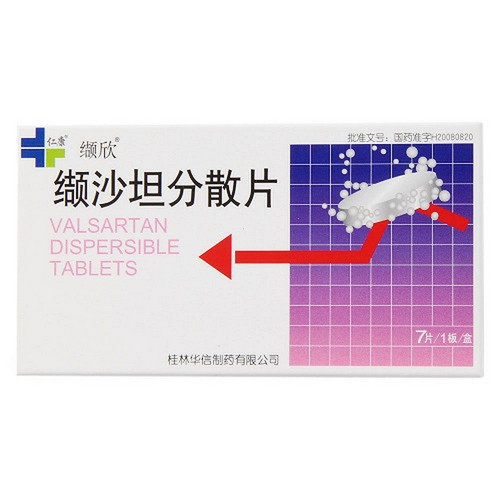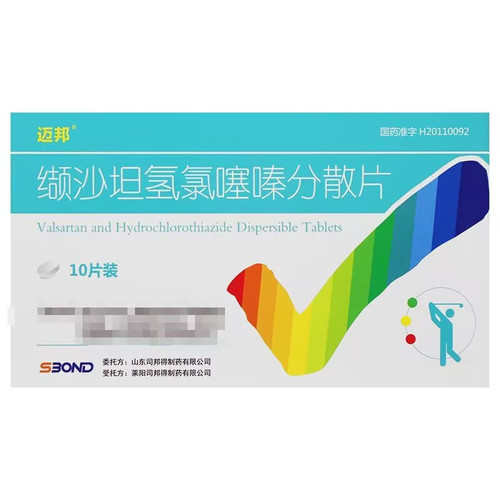Product Overview
[Drug Name]
Generic Name: Valsartan Dispersible Tablets
Trade Name: Linping Valsartan Dispersible Tablets 80mg*14 Tablets
Pinyin Code: LinPing ZuoShaTanFenSanPian 80mg*14 Tablets
[Main Ingredient]
Valsartan
[Properties]
This product is a white tablet.
[Indications/Main Functions]
For the treatment of mild to moderate essential hypertension.
[Specifications]
80mg*14 tablets
[Dosage and Administration]
Recommended dose: 80mg once daily. Dosage is not affected by race, age, or gender. It can be taken with or without food (see Absorption). It is recommended to take the drug at the same time each day (e.g., in the morning). A definitive antihypertensive effect is achieved within two weeks of treatment, and maximum efficacy is achieved after four weeks. If the antihypertensive effect is unsatisfactory, the daily dose can be increased to 160mg, or a diuretic can be added. No dose adjustment is required for patients with renal impairment (contraindicated for severe renal failure) or non-biliary, non-cholestatic hepatic impairment. Pinsartan can be used in combination with other antihypertensive drugs.
[Adverse Reactions]
Angioneurotic edema, rash, pruritus, and other hypersensitivity reactions such as serum sickness and vasculitis. Rarely, elevated liver function tests may be observed. Other adverse reactions with an incidence of less than 1% include edema, asthenia, insomnia, rash, and decreased libido. Patients with essential hypertension receiving pinsartan do not require specific laboratory monitoring.
[Contraindications]
1. Hypersensitivity to any of the ingredients. 2. Pregnancy (see Pregnancy and Lactation). 3. There is no experience with this drug in patients with severe renal failure (creatinine clearance <10 mcg/min).
[Precautions]
1. Hyponatremia and/or Hypovolemia: In rare cases, patients with severe sodium deficiency and/or hypovolemia (e.g., high-dose diuretic use) may experience symptomatic hypotension when starting treatment with this drug. Hyponatremia and/or hypovolemia should be corrected or the diuretic dose reduced before starting treatment. If hypotension occurs, the patient should be placed in a supine position and, if necessary, receive intravenous normal saline. Treatment with this drug should be resumed after blood pressure stabilizes. 2. Renal Artery Stenosis: Twelve patients with secondary renovascular hypertension due to unilateral renal artery stenosis received this drug for four days without significant changes in renal hemodynamics, creatinine, or blood urea nitrogen (BUN). Because other drugs that act on the RAAS may increase BUN and creatinine in patients with unilateral or bilateral renal artery stenosis, monitoring is recommended to ensure safety. 3. Renal Impairment: No dose adjustment is required for patients with renal impairment. 4. Hepatic Impairment: No dose adjustment is required for patients with hepatic impairment. The valsartan dose should not exceed 80 mg/day in patients with mild to moderate hepatic impairment. Valsartan is excreted primarily unchanged in the bile. Excretion is reduced in patients with biliary obstruction (see Pharmacokinetics). Therefore, caution should be exercised when using valsartan in such patients. 5. Early pregnancy (first trimester): Gestational category B. Animal studies have shown no risk to the fetus. 6. Mid- and late pregnancy (second and third trimesters): Gestational category D. 7. There is evidence of fetal harm in humans, but the benefits outweigh the risks of treatment. Given the mechanism of action of angiotensin receptor antagonists, fetal harm cannot be ruled out. Drugs that directly act on the RAAS during mid- and late pregnancy can cause fetal harm or death. Renal perfusion begins in the second trimester, and this condition is dependent on the development of the RAAS system. Therefore, the risk is increased with this drug during mid- and late pregnancy. 8. Like other drugs that directly act on the RAAS, this drug is not suitable for use during pregnancy. If pregnancy is discovered during treatment, valsartan should be discontinued as soon as possible. All newborns exposed to this drug in utero should be closely monitored to ensure adequate urine output, prevent hyperkalemia, and monitor blood pressure. If necessary, appropriate treatment measures (such as rehydration) should be taken to eliminate the drug. Pinsartan can be excreted in rabbit breast milk. There are currently no studies on breastfeeding women, so this product should not be used during breastfeeding.






